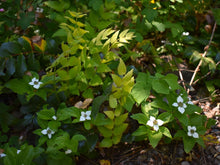
Cornus unalaschkensis
Bunchberry is a darling groundcover in the dogwood family. Its green, glossy leaves emerge each spring, followed by an exceptionally showy, four “petaled” creamy white flower that attracts pollinators to the shade garden. Interestingly, these “petals” are actually “floral bracts” and upon closer inspection, you’ll be delighted to see a cluster of tiny flowers at the center. In fall, the leaves turn a rusty hue and the flowers evolve into a tight little bunch of bright red berry-like drupes that are food for backyard birds.
- Plant type/canopy layer: deciduous, perennial, herbaceous plant
- Size at maturity: 1-4” tall, 3-8” wide
- Light requirements: part shade to full shade
- Moisture requirements: moist soil, may require moderate summer water
- Bloom time: May - Aug (May - July in the Portland Metro area)
- Growth rate/ease: medium to fast growing, moderately difficult to grow, but will spread effortlessly in the right conditions
- Wildlife support: flowers attract and provide nectar for adult butterflies, bees and other insect pollinators; overall plant is a caterpillar host plant and larval food source for native butterflies and moths
- Native habitat/range: common in moist forests west of the Cascades as well as shady bogs, fens and wetlands from sea level to 1800m. From northern California, north to Alaska. Portland Plant List - yes.
- Special features & uses: landscape uses include groundcover in shady pollinator gardens and woodland gardens; traditionally, the Bella Coola, Haisla and Hanaksiala peoples (of British Columbia) eat ripe berries mashed with sugar and oolichan grease and dry them for winter use
Gardening with Bunchberry: Bunchberry will make an absolutely charming semi-evergreen groundcover in special, moist and humus-rich areas of your shade garden. Be sure to work lots of rotting bark, wood, etc. into the soil when planting - and to leave fallen fall tree and shrub leaves on the ground for the nutrients and acidity. In its natural habitat, it is common to see bunchberry growing on nurse logs in luxurious old-growth areas of the forest. Given these types of conditions, it spreads wonderfully by runners and seeds. If you’re lucky, it may even bloom twice a year (late spring and again in late summer).
Photo Credits 1-5: Nikkie West, Sparrowhawk Native Plants
Photo Credits 6, 7: "Cornus unalaschkensis" by gertjanvannoord is licensed under CC BY-ND 2.0.













